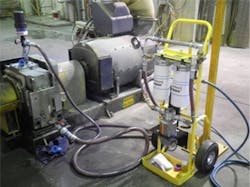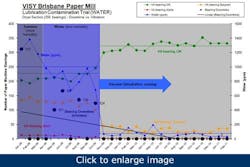In 1948, Visy Paper (www.visy.com.au) was started by the Pratt family in Melbourne, Australia, as a manufacturer of corrugated cardboard boxes. Today, Visy is a packaging, paper, and recycling company that employs more than 5,500 people and operates in more than 120 sites across Australia, New Zealand, Thailand, Vietnam, and Malaysia, with additional trading offices in Singapore and China. Visy also has a sister company, Pratt Industries USA, which employs an additional staff of 3,500 in North America.
Beyond the actual manufacturing of products, Visy operates collection and recycling services across Australia and New Zealand. In the most recent fiscal year, the company produced more than 680,000 tons of fiber packaging, 623 million steel food cans, 1.4 billion beverage cans, 836 million beverage cartons, 2 billion polyethylene terephthalate (PET) containers, and 646 million units of food plastics. In the same year, Visy recovered more than 1.4 million tons of paper and cardboard, 489,000 tons of glass, 67,000 tons of plastics, and 30,000 tons of metals to be recycled.
“In 2009, the Visy Paper Gibson Island plant embarked on a journey to improve reliability and reduce engineering downtime,” explains Lee Taylor, national reliability manager for Visy. “The plant decided to concentrate on lubrication as a major area of improvement. Utilizing a back-to-basics approach, Visy Paper Gibson Island has achieved incredible results in a short amount of time.” For its ability to execute and transform to excellence in machinery lubrication, the company has received the John R. Battle Award from the International Council for Machinery Lubrication (ICML, www.lubecouncil.org). Taylor, who also is the former Gibson Island site reliability manager, nominated Visy Paper for the award.
[pullquote]The Visy plant’s “keep it simple” reliability strategy focused mainly on balancing, aligning, lubricating, tightening, and inspecting equipment assets. The plant teamed up with Sigma Reliability Solutions (www.sigma-reliability.com). The plant’s immediate emphasis was to lubricate and tighten. This strategy has gone a long way, reducing engineering downtime by 64% in the first 30 months, with at least two-thirds of that attributable to improved lubrication practices.
Visy’s journey began with its engineering and lubrication technicians attending Noria’s lubrication training, followed by ICML certification. These new in-house experts led an effort that included Visy-developed in-house training on lubrication, oil sampling and testing, and fastening techniques. “These training modules are now given every 12 months,” says Taylor. “Visy currently has a standard for its lubrication personnel with outlined job descriptions, KPIs, and professional development plans. The ICML Machine Lubrication Technician (MLT) Level I certification has become an efficient hiring tool for management at Visy and is a minimum requirement for lubrication personnel.”
Visy, with the help of Drew Troyer, founder of Sigma Reliability, started with a site lubrication audit or gap analysis. This proved essential in steering the correct direction through quarterly re-gap reviews. Gap areas included lubricant selection, rationalization, storage, color coding, transfer, contamination exclusion and removal, baring sealing, oil analysis selection, tests, targets and alarms, ease of equipment visual inspection, and lubrication PM creation, rationalization, and management, as well as training/certification standards (Figure 1).
Figure 1. A lubrication audit and gap analysis proved essential in steering the correct direction through quarterly reviews.
The main areas of focus were contamination control, storage, oil analysis, and lubrication PM task management. The oil analysis program was revised, and equipment was added or removed from the database based on a criticality assessment of more than 1,500 plant assets. The current test slate was modified so that the plant ws monitoring the correct tests for turbines, gearboxes, and bearing and hydraulic systems. The target/caution/alert limits were also modified to better suit the industry and maximize equipment reliability.
Visy also made a capital investment in the construction of a world-class lube room, employing current best practices. The new room has been designed to house state-of-the-art storage and transfer equipment, and it’s fitted to provide all necessary filtration of lubricants. Large and small oil tanks have filtered recirculation. These tanks are piped directly to all the plant bearing/hydraulic tanks. A color-coding standard was developed for all oils/greases and is fully utilized in the store, as well as throughout the plant. Oil Safe containers from Fluid Defense (www.fluiddefense.com) are now used everywhere in the plant and adhere to the color-code standard. The store also strictly complies with a 5S system.
An area of major focus has been the PM routes and schedules, as well as integration into the computerized maintenance management system (CMMS). For more than 1,500 lubricated components, information on speed, contamination, orientation, moisture, temperature, vibration, bearing name, bearing type, bearing bore/outside diameters, and bearing width was recorded. This vital information was used to calculate lubricant viscosity, type, volume, and relubrication frequency. Routes were then created, and schedules produced. A motor reliability strategy saw all critical motors greater than 100 kW use electromechanical auto-lubricators. This one-off investment ensures better motor reliability and automates the task of motor lubrication.
{pb}Figure 2. Visy’s lubrication strategy has resulted in better reliability, conformance to cleanliness targets, fewer shut jobs, and lower lubricant spend.
Head space management has been implemented on all turbines and bearing and hydraulic systems, as well as critical gearboxes with the use of various desiccant breathers from Des-Case (www.descase.com). Critical systems have also been equipped with full-time water and particle filtration. Time-based shut job oil changes have almost been eliminated, replaced by run-time condition-based tasks such as filter cart cleaning (wear and contamination) and top ups (additive replenishment), in conjunction with oil analysis recommendations. This has resulted in better reliability, conformance to cleanliness targets, fewer shut jobs, and lower lubricant spend. Lubricants are also transferred to equipment through filtered drum toppers, ensuring new oil is clean (Figure 2).
When the program began more than two years ago, the 15,000-liter main lubrication tank, feeding almost 350 paper machine bearings, constantly operated at 950 ppm water and ISO19/16, which is quite typical for most paper machines. The Visy team challenged itself to achieve more than 100 ppm water and an ISO 13/10 level in the main bearing lubrication tank. Visy invested in a large vacuum dehydrator and a low flow 2-micron off-line polishing kidney filter. Within one month, the water level decreased from an average of 950 ppm to less than 100 ppm. It also reduced the contamination levels over a few months, taking about one month to drop each ISO level. This work was a major contributor to reducing engineering downtime. Bearings with minor defects stabilized, and high-frequency vibrations disappeared. This was due to increased film strength and reduced three-body abrasive wear. Monthly dryer can bearing changes were changed with one per year over the past three years (Figure 3).
Figure 3. Metrics were used to track the effect of lubrication best practices on plant reliability, costs, and safety.
Metrics were also used to track the effect of lubrication best practices on plant reliability, costs, and safety. Overall lubrication effectiveness (OLE), based on Sigma’s system, was implemented. The Visy plant now tracks lubrication PM and oil cleanliness/health compliance. “With these metrics in check, it’s an easy road to maximum equipment availability,” says Taylor. “Oil usage, equipment downtime, and bearing/gearbox/motor spend are also tracked by the accounting department.”
Closing the existing lubrication practices gaps and tracking the quantifying benefits of doing so have armed Visy’s reliability team with the persuasive tools needed to gain support from management for a greater mission of reliability for the company as a whole. Visy has even added reliability to its mission statement. “The company has approved and currently is rolling out the full lubrication programs at four of its other sites, with future plans for the lubrication program at the remaining four sites in 2013,” adds Taylor.
Visy’s example proves how starting with the basics, keeping it simple, and investing in world-class maintenance and reliability, particularly lubrication practices and personnel, can translate into enormous improvements. These improvements in turn can positively affect the reliability, maintainability, availability, yield, profitability, and safety of a plant.



